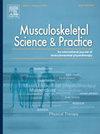Stair climb muscle power is associated with gait speed, sit-to-stand performance, patient-reported outcomes and objective measures of mechanical muscle function in individuals with knee osteoarthritis – secondary analysis from an RCT
IF 2.2
3区 医学
Q1 REHABILITATION
引用次数: 0
Abstract
Background
Mechanically measured leg extensor muscle power (LEP) predicts functional performance, patient-reported outcomes (PROMs) and mechanical muscle function in patients with knee osteoarthritis (OA). The stair climb test (SCT) have been used to assess LEP in clinical populations, but the relationship between SCT derived LEP and functional- and self-reported outcome measures in patients with knee-OA remains unknown.
Objectives
To investigate the relationship between LEP derived from SCT, and patient-reported outcomes (PROMs), functional performance, knee extensor muscle strength (MVIC), rate of force development (RFD) and Nottingham LEP in individuals with knee-OA.
Design
Cross-sectional study.
Method
SCT power was obtained in 96 knee-OA patients (age 56.9 ± 7.7 yr. males n = 47, females n = 49). The dependent variable was SCT power, while independent variables included 4 × 10 m fast-paced walk (4x10m-FWT), sit-to-stand (STS), STS power, KOOS, Oxford Knee Score (OKS), LEP, MVIC, and RFD.
Results
There were strong correlations (r = 0.72–0.80, p < 0.01) between SCT power and 4x10m-FWT and STS. There were weak-to-moderate correlations (r = 0.22–0.42, p < 0.05) between SCT power versus OKS and all KOOS subscales. Moderate correlations were observed between SCT power and Nottingham LEP, MVIC, and RFD (r = 0.53–0.64, p < 0.01).
Conclusions
SCT power correlates positively with functional performance, PROMs and mechanical lower limb muscle function in male and female individuals with knee-OA.
在膝骨关节炎患者中,爬楼梯的肌肉力量与步态速度、坐立表现、患者报告的结果和机械肌肉功能的客观测量有关——来自一项随机对照试验的二次分析
机械测量的腿伸肌力量(LEP)可以预测膝关节骨关节炎(OA)患者的功能表现、患者报告的结果(PROMs)和机械肌肉功能。爬楼梯试验(SCT)已被用于评估临床人群的LEP,但SCT衍生的LEP与膝关节炎患者的功能和自我报告的结果测量之间的关系尚不清楚。目的探讨膝关节oa患者SCT所致LEP与患者报告预后(PROMs)、功能表现、膝关节伸肌力量(MVIC)、力发展率(RFD)和Nottingham LEP之间的关系。DesignCross-sectional研究。方法对96例膝关节炎患者(年龄56.9±7.7岁,男47例,女49例)进行sct分析。因变量为SCT功率,自变量为4 × 10米快节奏步行(4x10m-FWT)、坐立(STS)、STS功率、oos、牛津膝关节评分(OKS)、LEP、MVIC和RFD。结果两组间存在强相关性(r = 0.72 ~ 0.80, p <;0.01) SCT功率与4 × 10m- fwt和STS之间。存在弱至中度相关性(r = 0.22-0.42, p <;0.05) SCT功率与OKS和所有kos分量表之间的差异。SCT功率与Nottingham LEP、MVIC和RFD之间存在中等相关性(r = 0.53-0.64, p <;0.01)。结论sct功率与男性和女性膝关节炎患者的功能表现、PROMs和机械下肢肌肉功能呈正相关。
本文章由计算机程序翻译,如有差异,请以英文原文为准。
求助全文
约1分钟内获得全文
求助全文
来源期刊

Musculoskeletal Science and Practice
Health Professions-Physical Therapy, Sports Therapy and Rehabilitation
CiteScore
4.10
自引率
8.70%
发文量
152
审稿时长
48 days
期刊介绍:
Musculoskeletal Science & Practice, international journal of musculoskeletal physiotherapy, is a peer-reviewed international journal (previously Manual Therapy), publishing high quality original research, review and Masterclass articles that contribute to improving the clinical understanding of appropriate care processes for musculoskeletal disorders. The journal publishes articles that influence or add to the body of evidence on diagnostic and therapeutic processes, patient centered care, guidelines for musculoskeletal therapeutics and theoretical models that support developments in assessment, diagnosis, clinical reasoning and interventions.
 求助内容:
求助内容: 应助结果提醒方式:
应助结果提醒方式:


